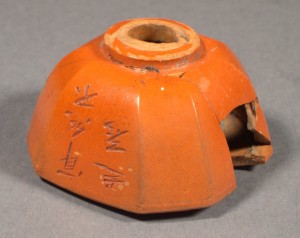Chinese Opium Pipe-Bowl
 Date of Creation: Qing Dynasty
Date of Creation: Qing Dynasty
Materials: Orange ceramic
Arrival in Dunedin: Unknown, presumed to be in use during the 1860s
Description: Broken at base and featuring Chinese characters
Researcher: Imogen Van Pierce
Photo Credit: Collection of Toitū Otago Settlers Museum. Permission of Toitū Otago Settlers Museum must be obtained before any re-use of this image.
History:
The Chinese developed the opium pipe-bowl during the seventeenth century for the vaporisation and inhalation of opium. This Chinese opium pipe-bowl was donated to Toitu Otago Settlers Museum by Phillip George in 1962, indicating it was from the Naseby area and the Hogburn goldfield. The detachable pipe-bowl was designed to fit into the ‘saddle’ or the metal fitting on the opium pipe to allow the direct inhalation of opium vapour by the smoker. Within the small bowl a lump of opium could be placed and gently heated by a traditional opium lamp.
Significance:
The Chinese opium pipe-bowl is significant as it represents the opium culture brought to New Zealand by the Chinese sojourners in the late nineteenth century. Opium pipe-bowls were traditionally made from fired earthenware or blue and white porcelain. More elaborate models carved from material such as jade denoted the owner’s socio-economic status in the Chinese community. The simple appearance of this item suggests it may have belonged to a Chinese gold miner or camp follower. As seen with this pipe-bowl, it was common for favourite Chinese characters or symbols for happiness, wealth and longevity to be engraved on opium pipe-bowls.

